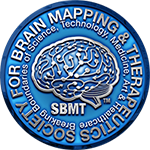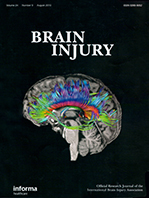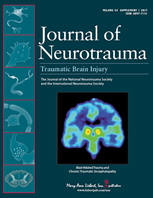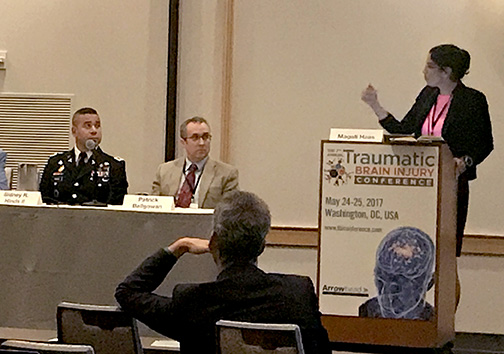Each month the US Department of Defense (DoD) Blast Injury Research Coordinating Office (BIRCO) highlights an accomplishment from the DoD Blast Injury Research Program's key program areas: Injury Prevention, Acute Treatment, and Reset. These highlights include new publications and products that add to the knowledge base for blast injury research, or novel strategies for preventing blast injury and enabling injured Service Members to return to duty and maintain an active lifestyle. Read more...
The BOP Tool is designed as a standalone application or as a feature within the Range Managers ToolKit (RMTK). It includes two modules:
The Blast Overpressure (BOP) Tool is an application designed to equip training range managers, safety officers, instructors, and other personnel with clear guidance on positioning to minimize blast exposure. This tool enables users to estimate the blast wave impact for specific weapons within a simulated training environment, helping to identify potential safety risks for individuals involved in the scenario.
Additional Resources:
Service members returning from theater are required to complete the Post-Deployment Health Assessment (PDHA), a lengthy form used to describe exposure to hazards and any associated symptomatology. Belding and colleagues from the Naval Health Research Center in San Diego, CA analyzed the PDHA records of 181,423 Marines from 2005 to 2012. Notably, 21% experienced an event that put them at risk for a TBI, the most common of these being blast exposure. Additionally, of the Marines with a "probable concussion," two-thirds were the result of a blast. In a particularly novel analysis, the investigators presented TBI data stratified by military operational specialty (MOS).
Specifically, "blast-associated concussions occurred most frequently among Marines working in tank and assault amphibious vehicles; infantry; engineer, construction, facilities, and equipment; military police; and motor transport MOSs."
Access the full report
(![]() 7 MB).
Portions of the analyzed data were published in Military Medicine1 and summarized
on our website.
7 MB).
Portions of the analyzed data were published in Military Medicine1 and summarized
on our website.
---
1 Belding, Jennifer N., et al. "Blast exposure and risk of recurrent occupational overpressure exposure
predict deployment TBIs." Military medicine (2019).
On September 12, 2019, the Journal of Experimental Neuroscience published a scientific review of blast-induced head trauma authored by COL Sidney Hinds and BIRCO contract staff. The title is "Blast-Related Traumatic Brain Injury: Current Concepts and Research Considerations." The manuscript was written to inform traumatic brain injury researchers of the complexities of blast overpressure induced head trauma and its comparability to blunt mechanisms of head trauma. Also discussed is the potential for blast overpressure biomarkers, the utility of future biodosimeters to link blast exposure to health outcomes, and variables that predict sustaining a head injury and/or exacerbate psychological conditions. This manuscript complements findings from recent BIRCO sponsored State-of-the-Science meetings and emphasizes that proposed future research should be grounded in the current evidence-base.
Download the article
(![]() 616 KB)
616 KB)
Save the Date! The DoD Blast Injury Research Coordinating Office (BIRCO) is sponsoring a breakout session at this year's Military Health System Research Symposium (MHSRS) titled "Approaches for Monitoring Warfighter Blast-Related Exposures in Training to Develop Effective Safety Standards." MHSRS will be held August 19-22, 2019 in Kissimmee, FL. More information including registration details can be found at www.mhsrs.net.
This session will explore methods for monitoring Service member exposures to blast-related health risks associated with weapons firing during training. Quantifying exposure is important for determining the potentially injurious effects of exposures and for using the acquired data to establish effective training safety standards that protect Service member health while maximizing training effectiveness to enhance lethality on the battlefield. Potentially hazardous exposures include but are not limited to blast overpressure, impulse noise, and inhaled propellant combustion products. The presentations and discussion will focus on (1) exposure monitoring methods such as wearable and environmental sensors; (2) studies that link exposure data to blast-related injuries such as auditory, lung, and brain injury; and (3) processes for developing safe exposure standards that enable effective training. The research and concepts presented during this session address the key components of the FY18 The National Defense Authorization Act (NDAA), Section 734 mandate for the DoD to monitor Service member blast exposures.
BIRCO Director, Mr. Michael Leggieri will moderate this session on Tuesday. August 20, 2019, 3:30-5:30 PM EST.
| 1530 | Introduction | Michael Leggieri |
| 1530-1545 | Mh-60 Direct Action Penetrator Crew-member Exposure Study | CW5 Adam Jarvis, USA |
| 1545-1600 | Monitoring Occupational Overpressure Exposure: Environmental Sensors, Neurocognitive Performance, Physiological Responses, and Service Member Initiative | Walter Carr, Ph.D. |
| 1600-1615 | A Computational Framework for Personalized Monitoring of Blast Exposure in Military Training And Operations | Andrzej Przekwas, Ph.D. |
| 1615-1630 | Structural and Functional Neuroimaging in Career Breachers | James Stone, Ph.D. |
| 1630-1645 | Auditory Effects of a High Overpressure Weapon System – The Multi-Purpose Anti-tank Anti-personnel Weapon System (MAAWS) | Nancy Vause, Ph.D. Melissa Webster |
| 1645-1700 | Potential Cause of Primary, Blast-induced Brain Injury: Direct vs. Indirect Mechanisms | Jaques Reifman, Ph.D. |
| 1700-1715 | Validation of Injury Against Bowen's Data | Brissi Zagadou, Ph.D. |
| 1715-1730 | Transparent Viscoelastic Hydrogels to Mimic White and Gray Matter for Improved Test Objects for Blast TBI Studies | Michaelann Tartis, Ph.D. |
On Wednesday, August 21, 2019, thirty-one posters will be presented on the "Approaches for Monitoring Warfighter Blast-Related Exposures in Training to Develop Effective Safety Standards." This poster session will be held between 10:00 and 12:00 EST.
For questions regarding this session, please contact Ms. Susan Taylor at susan.a.taylor40.civ@mail.mil.
The DoD Blast Injury Research Coordinating Office (BIRCO) and DoD/VA Vision Center of Excellence (VCE) are co-sponsoring a breakout session at this year's Military Health System Research Symposium (MHSRS) titled "Ocular Injuries caused by Exposure to Blast Overpressure." MHSRS will be held August 19-22, 2019 in Kissimmee, FL. More information to include registration details can be found at www.mhsrs.net.
This session will examine the evidence and possible mechanisms of unique ocular injuries caused by exposure to the blast overpressure generated by explosive weapons, such as improvised explosive devices (IEDs), and explore potential strategies to prevent these injuries. The talks and discussion will focus on: (1) clinical evidence of primary blast-induced injuries to the eye and visual system observed in Service members who were exposed to explosive weapons; (2) the application of computational modeling tools, such as finite element modeling, to elucidate the fundamental mechanisms of blast-induced ocular injuries; (3) studies using animal models to establish a link between blast overpressure exposure and ocular and vision injury, and to support the validation of computational models; and (4) proposed strategies to protect against blast-induced ocular injuries.
BIRCO contract support, Daniel Bryden, PhD (Booz Allen Hamilton) will moderate this session which will take place on Monday August 19, 2019 at 1:30-2:30 EST.
| 1330-1340 | A Century Of The Military Blast Eye: "Atmospheric Concussion" Eye Injuries In The Great War And Now | COL (Ret) Robert Mazzoli, MD Vision Center of Excellence |
| 1340-1350 | Post-injury Treatment With Microparticles And Erythropoietin Protects Against Repeat Blast-induced Optic Neuropathy By Blocking Oxidative Stress | Tonia Rex, PhD Vanderbilt University Medical Center |
| 1350-1400 | Antibodies Against Lysophosphatidic Acid Protect Against Blast-induced Ocular Dysfunctions | Peethambaran Arun, PhD Walter Reed Army Institute of Research |
| 1400-1410 | Experimental Research On Blast-induced Ocular Trauma: Methodologies Are Too Heterogeneous | James Karesh, MD Vision Center of Excellence |
| 1410-1420 | Artificially Intelligent Risk Analysis Model For Estimating Primary Blast Vision Loss | Michael Smolek, PhD U.S. Army Aeromedical Research Laboratory |
| 1420-1430 | Discussion | Daniel Bryden, PhD Booz Allen Hamilton |
On Wednesday, August 21, 2019, the "Ocular Injuries caused by Exposure to Blast Overpressure" poster session will be held between 10:00 and 12:00 EST.
| Analysis Of Far Forward Ocular Trauma Among Combat Casualties In Afghanistan | Ms. Jennifer Trevino, MBA U.S. Army Institute of Surgical Research |
| Severe Ocular Injuries During Israeli Defense Force Low Intensity Combat And The Use Of Protective Eyewear | CPT Avishai Tsur The Trauma and Combat Medicine Branch, Israel Defense Force |
| Long-term Prognosis Of Patients With Ocular Blast Injuries | CPT Alexander Stoddard Walter Reed National Military Medical Center |
| Preservation Of Vision Following Severe Ocular Trauma Through The Application Of Nanofiber-reinforced Hydrogel Bandages | Lindsay Woodard, PhD Luna Innovations, Inc. |
| Low-intensity Repeated Blast Exposure Leads To Visual System Damage In Rats | James DeMar, PhD Walter Reed Army Institute of Research |
| Blast Injury Prevention Standards Recommendation (BIPSR) Process: Ocular Blast Injury Type | Ms. Jennifer Lombardo The MITRE Corporation |
For specific questions regarding this session, contact Daniel Bryden at daniel.w.bryden.ctr@mail.mil.
On August 11-16, 2018, COL Sidney Hinds II, Blast Injury Research PCO, Brain Health Research Program Coordinator, participated in the Neurotrauma 2018 joint society symposium sponsored by the International and National Neurotrauma Societies and AANS/CNS Section on Neurotrauma and Critical Care, and held at the Westin Harbour Castle, Toronto, Canada. This was the third joint symposium designed to provide an opportunity to broadly share the most up-to-date scientific and clinical evidence about brain and spinal cord trauma with the neurotrauma research and treatment community. Basic and clinical researchers showcased their work in plenary sessions, podium lectures, and through poster presentations. Researchers from US Army Medical Research and Materiel Command (USAMRMC) laboratories, Office of Naval Research (ONR), and research performers funded by the Department of Defense (DoD) were included among those presenting their work to colleagues from institutions worldwide. COL Hinds contributed to a poster presented at the conference on ENIGMA: Enhancing Neuroimaging Genetics through Meta-Analysis. PCO participation in this meeting supports the congressionally mandated EA responsibility to promote information sharing and partnerships, to disseminate blast injury research information, and to identify blast injury knowledge gaps.

The Brain Health Research Program Coordinator, COL Sidney Hinds, attended the 70th annual meeting of the American Academy of Neurology (AAN) held on April 21-27, 2018 in Los Angeles, CA. The meeting included a session on military-related neurological issues and COL Hinds presented a poster describing the methodology of the Post-Traumatic Headache Clinical Recommendation (CR) research study, which is a collaboration among DVBIC, USUHS and USAMRMC.
The Brain Health Research Program Coordinator, COL Sidney Hinds, attended the 2nd Annual NCAA-DoD Grand Alliance Concussion Conference held on April 20, 2018 in West Point, NY. During the conference, concussion experts and researchers shared findings from the NCAA-DoD Grand Alliance. COL Hinds is a member of the NCAA CARE Consortium Scientific Advisory Board and was an invited panelist for the conference session "Variances Between Student-Athlete and Non-Student-Athlete Cadet Return-to-Activity."

The Brain Health Research Program Coordinator, COL Sidney Hinds, was an invited speaker at the SPIE Defense + Commercial Sensing Conference held on April 15-19, 2018 in Orlando, FL. In his presentation, "DoD Blast Injury Research PCO: Perspective On Brain/Human Computer Interface Technologies For Injury Prevention and Diagnosis," COL Hinds discussed the needs of the Service members and medical personnel to provide scalable medical care along the roles of care and highlighted research being done in neuroimaging.

The Brain Health Research Program Coordinator, COL Sidney Hinds, was an invited speaker at the 15th Annual World Congress of the Society for Brain Mapping & Therapeutics (SBMT) held on April 13-15, 2018 in Los Angeles, CA. The purpose of the meeting was to bring together physicians, scientists, policy makers, funding agencies and industry to further the advances and applications in brain and spinal cord mapping and image guided therapies. In his presentation "DoD Blast Injury Research Program Coordinating Office: Efforts in Brain Injury Research," COL Hinds highlighted several PCO initiatives including the BIPSR Process, US-India and NATO collaborations, and the International State-of-the-Science meeting series.

Ms. Susan Taylor, Blast Injury Research Program Coordinator, presented an overview of the PCO and International State-of-the-Science (SoS) meeting process at the 126th annual Association of Military Surgeons of the United States (AMSUS) meeting during a session titled, "State of Science Report to Minimize Impact of Wound Infections in Blast-Related Injuries."
The purpose of the session was to discuss the recommendations made during the PCO-organized 2016 SoS Meeting on Minimizing the Impact of Wound Infections Following Blast-Related Injuries. The session was led by COL Kirby Gross, Army Trauma Training Detachment at Ryder Trauma Center and included Dr. David Tribble, Science Director, Infectious Disease Clinical Research Program at Uniformed Services University of the Health Sciences and Dr. James Ficke, Chief of Orthopaedic Surgery at Johns Hopkins Hospital. All three served as expert panelists during the 2016 SoS meeting and were actively involved in developing the final recommendations.
During the AMSUS session, the panel discussed the critical need for programs to improve outcomes following blast-related wound infection. Policy changes supporting continuous learning and maintenance of trauma data registries are equally as important as research to develop new treatment strategies. Of particular interest is maintaining data registries, including the DoD Trauma Registry, Military Orthopaedic Trauma Registry (MOTR), and Trauma Infections Disease Outcomes Study (TIDOS). Data from these registries are instrumental to understanding blast-related wound infections and designing research programs to improve outcomes. Other points of discussion included establishing requirements to perform clinical research in theater during interwar periods and the importance of a learning health system to capture and distribute best practices.

PCO Director, Mr. Leggieri, and several current and former members of USAMRMC, including Drs. Curley, Pacifico, and Tortella, are authors on a recent article published in a special edition issue of the journal Brain Injury, entitled "Preclinical modelling of militarily relevant traumatic brain injuries: Challenges and recommendations for future directions." The article captured the discussions that took place during an August 2015 US Department of Veterans Affairs (VA) State-of-the-Art meeting, which brought together stakeholders from the VA, DoD, Department of Health and Human Services (DHHS), and academia to assess traumatic brain injury (TBI) research, identify gaps, and recommend future research to fill the gaps. Mr. Leggieri contributed to the article by emphasizing the need to accurately characterize Service member blast exposures, including exposures to repeated occupational levels of blast overpressure during weapons training, and the importance of creating relevant blast exposures in the laboratory to support blast-related brain injury research.

The PCO organized the 2015 International State-of-the-Science Meeting "Does Repeated Blast-Related Trauma Contribute to the Development of Chronic Traumatic Encephalopathy (CTE)?" to address questions about the potential association between head injury and CTE. In September 2017, the PCO published the proceedings of this meeting in a supplement issue of the Journal of Neurotrauma, "Blast-Related Trauma and Chronic Traumatic Encephalopathy."

The Brain Health Research Program Coordinator, COL Sidney Hinds II, represented the Department of Defense (DoD) Blast Injury Research Program Coordinating Office (PCO) at the 35th Annual National Neurotrauma Society (NNS) Symposium held July 8-12, 2017, in Snowbird, Utah. In addition, COL Hinds was an invited presenter at the pre-meeting workshop on "Environmental Sensor use for Quantifying Neural Exposure to Inertial and Blast Forces." The primary objective of this workshop was to increase understanding of the diagnosis and prevention of brain trauma by updating clinical and basic science researchers on the state of the science of environmental sensors. The workshop was jointly sponsored by the National Institute of Neurological Disorders and Stroke and Joint Program Committee-5/ Military Operational Medicine Research Program. COL Hinds' presentation covered a history of environmental sensors and the US Army Medical Research and Materiel Command's role in past, current, and future environmental sensor efforts. The day-long workshop provided a balance between the technology and physics of blast and blunt sensors and the clinical perspective of these sensors.
The remainder of the symposium consisted of scientific presentations, poster sessions, workshops, and networking events. Topics addressed included acute and chronic effects of traumatic brain injury (TBI) and spinal cord injury, emerging therapies, blast related injuries, and controversies in the field of brain injury and sports concussion. Dr. John Povlishock, Professor and Chair of the Department Anatomy and Neurobiology at Virginia Commonwealth University, provided a plenary anniversary presentation on the history of the TBI field and his experience investigating emerging theories of injury throughout his professional career. Attendees of the meeting included representatives from the DoD, other government agencies, academia, and industry.
The PCO prepares an annual report to the DoD EA for Medical Research for Prevention, Mitigation, and Treatment of Blast Injuries, that covers blast injury research efforts and programs within the DoD. The report is intended to inform senior DoD policymakers, researchers, and the public by highlighting blast injury research accomplishments of blast injuries from across the DoD. Read more...

Brain Health Research Program Coordinator, COL Sidney Hinds II, was an invited speaker at the 7th Annual Traumatic Brain Injury Conference hosted by Arrowhead Publishing in Washington, DC. The goal of this annual conference is to bring together scientists and clinicians from industry, academia, and government to discuss the latest breakthroughs in traumatic brain injury (TBI) research and clinical care. This year's interdisciplinary meeting brought together over 180 attendees representing expertise across the continuum of TBI care including injury prevention, treatment, and rehabilitation. Focus areas included preclinical models of brain injury, TBI biomarker development and validation, improvements in outcomes research, emerging tools for the diagnosis and assessment of TBI, and current clinical management across the spectrum of TBI severities. In addition to a wide range of presentations and panel sessions, the meeting also included poster sessions and numerous networking events.
COL Hinds' presentation, titled "Neuroimaging as a Biomarker for Traumatic Brain Injury," focused on the application of advanced neuroimaging techniques to aid in the diagnosis and treatment of TBI. He discussed one possible medical paradigm to put into perspective the efforts in TBI biomarker research and showcased recent efforts to apply advanced neuroimaging to the challenges associated with the heterogeneity of the TBI population. In addition, COL Hinds participated in a panel session in which he discussed translational gaps, applying research findings to TBI clinical diagnosis and treatment, sharing with attendees the best ways to develop research collaborations with military organizations.
COL Hinds' participation in the meeting supports to the Department of Defense Blast Injury Research Program's Executive Agent responsibilities to promote collaboration between academia, industry, and military researchers and to share recent advances in military neurotrauma related research.
The Brain Health Research Program Coordinator, COL Sidney Hinds II, was invited to participate in a panel at the 14th Annual World Congress hosted by the Society for Brain Mapping and Therapeutics (SBMT) on April 18, 2017. The Congress, held at the Millennium Biltmore Hotel in Los Angeles, California, brought together researchers, clinicians, policy makers, and funding agencies. The purpose was to exploit synergies among an interdisciplinary group of researchers to accelerate advances in brain and spinal cord injuries as well as image-guided therapies. Topics covered during the meeting include neurosurgery, neurology, psychiatry, radiology, neuroengineering, nano-bio-electronics, and healthcare policy.
COL Hinds' presentation, "Traumatic Brain Injury (TBI) Biomarkers: Objective Tests in a Heterogeneous Population," was included in the panel titled "Military Medicine: Distinguishing between TBI and Posttraumatic Stress Disorder (PTSD)," chaired by Dr. Maheen Adamson, Senior Scientific Research Director for the Defense and Veterans Brain Injury Center at the VA Palo Alto Health Care System. His presentation focused on the pathophysiology of TBI, current knowledge gaps in TBI research, and Department of Defense (DoD) sponsored efforts to identify potential fluid or imaging based biomarkers to diagnose TBI and predict long-term patient outcome following injury.
Participation of the Brain Health Research Program Research Coordinator in conferences, such as the SBMT World Congress, supports the Executive Agent for the prevention, mitigation and treatment of blast injuries in fulfilling their responsibility to bring national and international awareness to brain trauma-related research and clinical practices information and facilitate collaboration among researchers and clinicians focusing on neurological and neuropsychological health across the DoD, other federal agencies, academia, and industry.

From March 29 through April 2, 2017, the Brain Health Research Program Coordinator, COL Sidney Hinds II, participated in the International Brain Injury Association (IBIA), 12th World Congress on Brain Injury in New Orleans, Louisiana. The IBIA World Congress is the largest gathering of international professionals working in the field of traumatic brain injury (TBI). The focus of the meeting included all facets of research, education, and clinical care. COL Hinds presented a case study illustrating the importance and use of the Department of Defense (DoD) Clinical Recommendations. In addition, he participated on a panel presentation titled "Approaches to the Evaluation and Treatment of Concussion: A Panel Discussion." Throughout the event COL Hinds continued to support the responsibilities of the DoD Executive Agent to promote partnerships and facilitate collaboration within the international TBI community through meeting with leaders from various organizations and research consortia.
The Brain Health Research Program Coordinator and well known US Army neurologist, COL Sidney Hinds II, was invited to give a presentation at the Military Medicine Partnership Conference and Expo, in Ellicott City, Maryland, on March 7, 2017. This presentation, "Blast-Induced Mild Traumatic Brain Injury (mTBI): Current State of the Science," was well received. COL Hinds focused on the ongoing work that the DoD Blast Injury Research Program Coordinating Office facilitates, including the International State-of-the-Science meeting series, fostering collaboration among DoD, federal agencies, academia and industry; identifying research and product gaps; providing input and addressing research requirements; and acting as consultants for partners who wish to share ideas. He stressed the need for a better understanding of TBI issues through prevention/protection to recovery and rehabilitation, emphasizing how blunt/sports related head injury research plays a large part in addressing blast injury knowledge gaps. These findings will assist in ensuring physical readiness for all Service Members for current and future combat.
The Military Medicine Partnership Conference and Expo, co-hosted by USAMRMC and National Defense Industrial Association (NDIA), is an opportunity for science and industry representatives to learn more about the DoD research, development, test and evaluation missions, programs and gap areas and to better understand the complexities of military medicine in the complex environment within which the military operates.
For more information on disseminating blast injury research information, read more...
Your 15 minute session will timeout in approximately 10 minutes.
If you're in the middle of entering information, please close this warning and save your progress (if possible) or finish up your task.
If your session fully times out, you will lose any un-saved work.
Your current Blast Injury Research Program session has expired.
Your next click will take you away from the private area, and you will lose any work you have in-progress.
Please enter your email address, and try again.